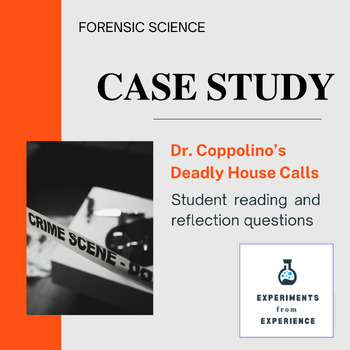True Crime Forensics Case Study: Dr. Coppolino's Deadly House Calls
Experiments from Experience
18 Followers
Grade Levels
Not Grade Specific
Subjects
Resource Type
Standards
CCSSRI.9-10.1
CCSSRI.9-10.10
CCSSRST.11-12.2
CCSSRST.11-12.8
CCSSRST.11-12.9
Formats Included
- Google Docs™
Experiments from Experience
18 Followers

Made for Google Drive™
This resource can be used by students on Google Drive or Google Classroom. To access this resource, you’ll need to allow TPT to add it to your Google Drive. See our FAQ and Privacy Policy for more information.
Also included in
- True crime is a creative and exciting way to teach scientific principles in your science classes! If you teach Forensic Science and are looking for some major cases involving forensic science, these are the perfect addition to your class! Murder, death investigations, blood spatter, stomach contentsPrice $24.99Original Price $26.73Save $1.74
Description
True crime... Murder, a mistress, and the question of scientific evidence in the courtroom - this case has it ALL!
This assignment includes an overview of the Dr. Coppolino case, which involves murders caused by an injection of a paralytic drug. The case is significant in the history of forensic science due to questions surrounding admissibility of scientific evidence into court. I always teach this case as a part of the introduction to forensic science unit.
This assignment includes the reading of the case overview, along with reflection questions and important vocabulary. This takes about one 45-minute class period.
Total Pages
Answer Key
N/A
Teaching Duration
45 minutes
Report this resource to TPT
Reported resources will be reviewed by our team. Report this resource to let us know if this resource violates TPT’s content guidelines.
Standards
to see state-specific standards (only available in the US).
CCSSRI.9-10.1
Cite strong and thorough textual evidence to support analysis of what the text says explicitly as well as inferences drawn from the text.
CCSSRI.9-10.10
By the end of grade 9, read and comprehend literary nonfiction in the grades 9-10 text complexity band proficiently, with scaffolding as needed at the high end of the range.By the end of grade 10, read and comprehend literary nonfiction at the high end of the grades 9-10 text complexity band independently and proficiently.
CCSSRST.11-12.2
Determine the central ideas or conclusions of a text; summarize complex concepts, processes, or information presented in a text by paraphrasing them in simpler but still accurate terms.
CCSSRST.11-12.8
Evaluate the hypotheses, data, analysis, and conclusions in a science or technical text, verifying the data when possible and corroborating or challenging conclusions with other sources of information.
CCSSRST.11-12.9
Synthesize information from a range of sources (e.g., texts, experiments, simulations) into a coherent understanding of a process, phenomenon, or concept, resolving conflicting information when possible.



